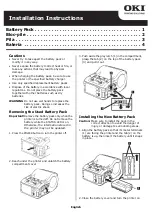
4
www.enersys-emea.com
MAINTENANCE AND INSPECTION
The optimum maintenance and inspection procedure will vary considerably
according to the application, number and critical nature of installations,
along with other commercial considerations.
It is advised that, in addition to the instructions detailed below, the Battery
Record Sheet as shown in Appendix B is utilised.
MONTHLY INSPECTION
SIX- MONTHLY INSPECTION
ANNUAL INSPECTION
As with monthly and six-month checks, the type of annual inspection is
based on the critical nature of installations, along with other commercial
considerations i.e. feasibility of reduced autonomy, manpower availability
etc. One method of checking the state of health of the battery is to perform
a partial discharge using the actual system as the load.
Example
For a system with a back-up autonomy time of 1 hours:
Switch off the main power supply and allow the battery to supply the
required back-up power to the load.
After approximately 15 minutes* measure and note the terminal voltage of
the individual monoblocs and the corresponding string from which the
measurement was taken. An example of a battery record sheet is shown in
Appendix B.
After all of the monoblocs have had their terminal voltages measured, the
main power should be returned to the system.
By reference to the noted values on the record sheet calculate the average
monobloc terminal voltage for each individual string.
From this value, calculate a voltage equating to 5% less than the average.
Monoblocs with a terminal voltage below the calculated value should be
considered for further monitoring or replacement to ensure maximum
system autonomy.
*The actual discharge duration is unimportant as the test is one of
comparison and does not have a specific pass/fail criteria. It should be
noted however that the longer the duration of the discharge is allowed to
continue before measurements are taken, the earlier it might be possible to
detect monoblocs prematurely failing.
It is only possible to check the actual capacity of the system battery by
performing a full discharge test on the battery to a known endpoint voltage.
Unfortunately, although this gives excellent battery maintenance cover,
it means that for a short period the battery will provide substantially
reduced autonomy. Hence this method should only be implemented during
times of complete system redundancy.
EnerSys
®
can design a tailor-made maintenance procedure when supplied
with the relevant information.
REJECT PROCEDURE AND DISPOSAL
REJECTION
Should a product, on receipt or otherwise, appear to be unserviceable
FIRST contact EnerSys detailing the circumstances.
Full details of date of shipment, commissioning records and all
maintenance records should be relayed.
DISPOSAL
All monoblocs for disposal should be shipped to a recognised scrap
recoverer, or regulated collection point.
EnerSys utilises a licensed reprocessor of lead and plastics. We will, at no
charge, dispose of batteries if they are delivered to our factory in Newport,
UK. Alternatively, please contact your local sales office who will be able to
assist with your disposal needs.
In the UK, this is a legal requirement and products should be disposed of in
accordance with the rules of the relevant Local Authority. The Local
Authority is required to maintain a list of their approved disposal and
recycling operators.
DO NOT INCINERATE END OF LIFE BATTERIES.
APPENDICIES
APPENDICIES
The following pages show the information listed below. If you have any
other requirements, please do not hesitate to contact our Sales Office or
your local agent.
APPENDIX A
THE DATASAFE
®
MX BATTERY RANGE - PRODUCT DETAILS
Notes- Weight is in Kg. A = Length; B = Width; C = Container; D = Height over terminals
Battery capacities increase with a higher temperature.
Unless otherwise stated all dimensions are in millimetres.
Battery Rating is measured in watts per cell at the 15 minute rate to
1.67 Volts per cell at 25°C.
For further information on any of our products, please contact our
Sales Office.
Measure total
battery voltage
1 Total battery
voltage on float
charge.
Adjust float
voltage as
specified in
Section 2
Recommended
float volts per cell
x number of cells
in series
Measure
individual
monobloc
voltages
2 Individual
monobloc
voltages on float
charge
Contact EnerSys
®
if non compliant
Within 5.0% of
the mean
Check for
damage or other
impairment
3 Appearance
If a concern is
found check the
cause and replace
the monobloc as
necessary
Check for
contamination by
dust, etc.
4 Cleanliness
If contaminated
ISOLATE
monobloc and
clean with a
damp soft cloth
Check for
corrosion of the
cubicle, battery
stand, connecting
cables and
terminals
5 General
condition
Perform cleaning,
corrosion
prevention
treatment,
painting, etc.
WHAT TO
METHOD
REQUIREMENT
ACTION
INSPECT
Measure total
battery voltage
1 Total battery
voltage on float
charge.
Adjust float
voltage as
specified in
Section 2
Recommended
float volts per cell
x number of cells
in series
WHAT TO
METHOD
REQUIREMENT
ACTION
INSPECT
12mx150
12
150
250
97
140
152
9.0
M6
12mx200
12
207
250
97
191
204
12.5
M6
12mx270
12
270
220
121
245
256
17.5
M6
Product
Nominal
Dimensions
Typical
Terminal
Type
Voltage
Rating
A
B
C
D
Weight
Thread


























